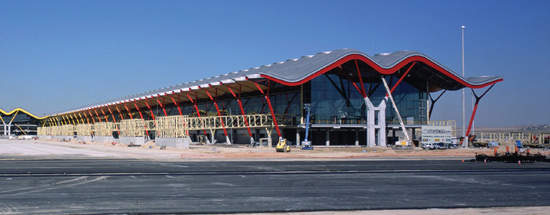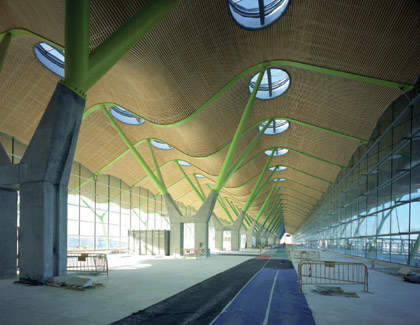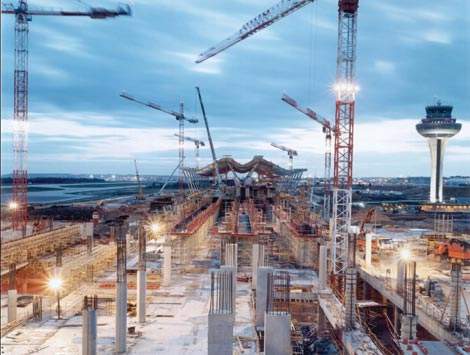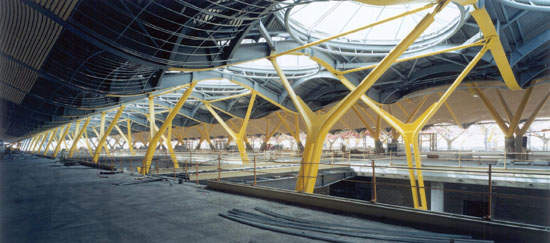Estudio Lamela’s design for the terminal at Madrid Barajas airport presents a bold but user-friendly space. The terminal can be easily extended if airport traffic continues to increase.
An airport is the gateway to a country. Arriving at an airport for the first time, passengers form their initial impressions of a country or city – impressions that can be permanent. It is no surprise, then, that airports have become emblematic buildings. Madrid-Barajas Airport is no different, establishing itself as a hub airport and one of the major gateways to Europe.
The drafting of the project for the new terminal area was the result of a competition initiated by Aena. Nearly 90 teams from different parts of the world participated in the competition, and only 11 projects were shortlisted.
In October 1997, a proposal submitted by a team comprising two architectural practices (Estudio Lamela from Spain and the Richard Rogers Partnership from the UK) and two engineering firms (Initec from Spain and TPS from the UK) was selected. The scheme was chosen for its simplicity, adaptability, robustness and flexibility.
PASSENGERS THE PRIORITY
The need for a relaxing atmosphere meant using materials and finishes that radiate calm. The inside of the roof is covered with bamboo, creating a warm feel, while the paving will be made of Spanish limestone, which is warm without being reflective and less hard than other materials such as granite.
Unlike most of its counterparts, the new airport terminal helps passengers relate to their surroundings. It is a huge building, but passengers are still able to find their way around, due to the number of visual references dotted throughout the terminal. The building has also been broken into segments to ensure a more manageable scale.
Other than the flexibility to accommodate future expansion, passenger well-being is the central tenet of the design. Among the new generation of airports – Osaka, Hong Kong, Kuala Lumpur, Denver and so on – only Madrid-Barajas Airport makes respect for the people who pass through it every day such a high priority. From outside, the building also complements the Madrid landscape, with its undulating shapes reminiscent of the surrounding hills.
DESIGN CONCEPT
The terminal building is earmarked for domestic flights and Schengen flights to the EU. The pier will be more than 1km long and cover an area of nearly half a million square metres, including 174 check-in desks. There will be 26 parking spaces for the aircraft, covering an area of nearly 300,000m², which will be linked to the main area through an automated underground train. The Automatic System Intraterminals People Mover will run 24 hours a day and cover the 2km between the two stops in only three minutes.
Another major innovation is the SATE automated baggage-processing system, which will allow the processing of about 16,500 pieces of baggage per hour. The system will place a sticker on the suitcases, complete with barcode, and using an optical reader move them along a 78km circuit of automatic conveyors to the right planes at a rate of 10m per second. Both the SATE and the automated train will travel through the same two-tier tunnel, with the train running on the upper level and the SATE on the lower level.
MODULAR DESIGN
Following the basic concept outlined in the original design proposal, the terminal building consists of three linear modules, complying with different functions according to passenger flows.
For departures, passenger processing will take place at the check-in area, after which passengers will be able to explore the retailing outlets towards the boarding pier.
For arrivals, the process will be reversed: passenger processing will take place in the landing pier and new arrivals will then proceed to baggage reclaim and the arrivals waiting room.
Such modules will be separated from each other by long, rectangular open spaces, ensuring natural daylight deep in the heart of the building. To further brighten up the terminal, there will also be an abundance of plant life throughout. These large inner courtyards allow the building to breathe and follow a clear environmental strategy – natural lighting and good air quality in pleasant surroundings.
The building will also comply with recommendations on the use of alternative energies, reduced energy consumption and reduced maintenance and running costs These spaces will be where all vertical passenger movement will take place, whether via the stairs, the ramps or the lifts.
ARCHITECTURAL GOALS
The project’s basic architectural goals include:
- Use of simple geometrical techniques, so that the layout is easily comprehensible to both passengers and staff
- A main building incorporating the sequential character of passenger processing through the departure and arrival modules
- Use of open spaces, known as ‘canyons’, to separate each longitudinal module from the next, simplifying orientation, reducing dependence on artificial lighting through increased day lighting, and improving the quality and overall perception of the space
- Architectural functionality that is clear to all users, whether they are departing, arriving or connecting, including lifts and moving walkways so that passengers can get around the terminal quickly and easily, and world class signage that can be easily understood by all international passengers
- An interior that is bright, non-oppressive and complements its physical surroundings, and an exterior that is light, transparent and subtly engaging
- Easy access to the airport and good internal links to the car parks and public transport for both departing and arriving passengers
- An adjacent green landing area for connecting flights
- Flexible and modular construction, using precast materials, to accommodate any future expansions and ensure a good quality-price ratio
- The flexibility to provide increased aircraft capacity if necessary and to adapt easily to future developments in the aviation industry
- Optimum acoustic absorption, fire resistance, air tightness and thermal insulation, as well as compliance with all the requisite standards of safety and comfort for a building of this type
STRESS-FREE CONSTRUCTION
With a surface area of 1.2 million square metres, the terminal at Barajas was widely considered to be the largest construction project in the world, as well as the largest single structure ever built. It was therefore important to standardise the construction as much as possible, not only in terms of facilitating the building process but also in allowing for any future expansions of the terminal.
It is therefore no surprise that one of the development’s guiding principles has been a modular approach to construction. For example, the use of iron for the most important structural elements has been crucial in achieving the requisite sense of space and light.
The three-storey terminal building is covered by a sinuous curved and vaulted roof, supported internally on pairs of canted columns. The facade and its so-called ‘kipper’ truss support structure were designed to be minimal and delicate, so as not to break the flow of the roof from inside to out.
Each module of the roof is supported by leaning and articulated iron columns. Lengthways, they are at 18m intervals and then branch off to support the main beams. Going across, there are four columns for each alignment: two central V-shaped ones and two Y-shaped ones at each end supporting the cantilevered roof.
COLUMNS AND TRUSSES
The columns consist of 14mm-thick hollow pipes, which are 800x480mm at the base and 480mm x 200mm at the head, where they support the main beams. The beams were designed according to the stress they would have to bear. The 72m ‘seagull wing’ profile has a section of 500mm x 30mm, while the stem consists of a 15mm-thick plate. The arch-shaped secondary beams are 3.5m each and support UPN 100 purlins.
The trusses are tensioned to resist wind loading and made of five horizontal stainless steel arms connected by pairs of stainless steel rods. The position and varying lengths of the arms create the fish-like shape (hence the name) and reflect the line of structural forces. The trusses are at 9m intervals, aligning with the main roof beams. They are pinned to the bottom flange of the beams with forked connectors and anchored at their bases to a post-tensioned concrete edge beam.
Each arm of the truss supports a transom and a set of paired 76mm-diameter Circular Hollow Sections (CHSs), bolted together with welded flanges and clad with profiled aluminium. Each transom in turn supports three 2.34m x 3m double-glazed panels. Gaps of 75mm were left between the glass panels to accommodate rotational movement. They were sealed with a concertina like extruded rubber gasket.
The bracing required to mitigate the horizontal stress has been achieved using a vertical thoric section linked to the upper iron structure of the roof and to the lower concrete beams. The stainless steel rods are under permanent tensile stress, but the thoric section guarantees their stability.
The trusses were factory-assembled, delivered to site and loosely pinned and bolted. A set of ties and jacks were set up behind them and tensioned to draw together the roof and floor beam to a maximum loading of 60t. The trusses were then attached, tested and loaded to 40t. The maximum horizontal movement of the facade will be about 15mm.
The versatility of the materials gives the new terminal a unique geometry, most strikingly in the roof and facade. Practically all the steel used is on view, with the building exposing its skeleton to the user. Features like the roof beams and the structure of the curtain wall create a sense of security, robustness, light and space.











